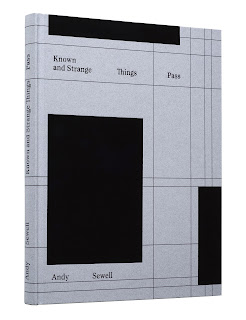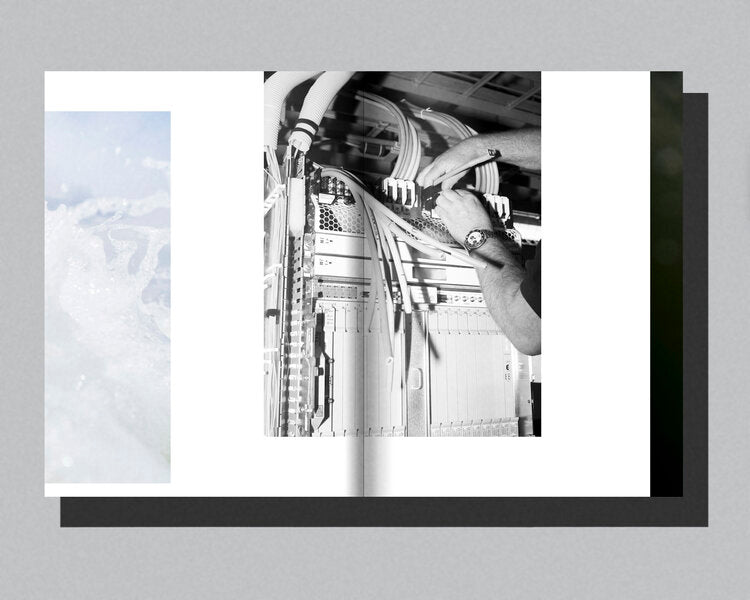 |
Known and Strange Things Pass by Andy Sewell.
|
Photographs by Andy Sewell
Skinnerboox, 2020. 192 pp., 9½x12½".
Even before I first saw Andy Sewell's edit for this project I knew it was going to be quite an unconventional photobook. ‘What's this new project about?’ I asked him over the phone a few days before our meeting, keen to see what he was up to after the success of Something Like a Nest published in 2014. ‘It's about the Internet. And the ocean. [Long pause] It'll be best to show you so I can explain’.
We met to look at an initial selection of images and talk about the ideas behind the project. In Known and Strange Things Pass there are two narrative strands working inextricably to create what I can best describe as a visual meditation: the idea that all the digital information of the Internet travels through a cable laid down across the ocean floor, and also the idea of time, from the instantaneous time of digital communication, to the slower, much more ancient time of the ocean.
In this first meeting I was interested to see how Sewell developed these two strands with his distinctive photographic style, and we talked about the big challenge of resolving the overall sequence and format of the book. Somehow he'd need to evidence how these two worlds coexist. On one hand there's the cable containing threads barely thicker than human hair, transporting digital information between two continents. And then there's also the Internet and the ocean as spaces and temporalities we can't really grasp. In Sewell's words: "the idea of it surprises me. It felt strange to think of the Internet as an object, as something tangible and concentrated through these cables. And I wanted to explore the way these vast, unknowable objects — the ocean and the internet — are physically as well as metaphorically entangled. To ask how they speak to each other, and to us?"
Looking at the first dummy and now the published book, I am excited to see how the various narrative strands were resolved through sequencing and design. Working together with designer Nicolas Polli, the layout breaks the limits of the page, using the white space of the unprinted paper to create pauses, to hint and extend the possible reading of the different sequences. The result is spatial — it gives us a sense of space, we see the shoreline at each end of the ocean, where the cable starts and ends — but also temporal, we can feel the slow sway of the ocean, in contrast to the instant of the phone text and the millisecond photographic exposure.
 |
What I admire the most about Sewell's work is his fixation with surfaces, with what one can call the materiality of things. Looking back to The Heath (2012) and Something Like a Nest (2014) one can see how carefully he crafts his images, not just by observing the world in detail, but through this observation managing to imbue the mundane with a sense of sculptural timelessness. In Known and Strange Things Pass, Sewell furthers this search into the expressive potential of this materiality: he is enthralled by the surface of the water and the rocky cliffs by the sea, but also by smeared computer screens within the dark spaces of concrete rooms full of metal racks and cables.
The combination of these detailed observations with the particularly spatial layout allows me to get lost, wondering about the immensity of the ocean, but also of the Internet. Also thinking about time: I imagine the extended time of geology, against the seemingly instantaneous time of digital communication. This ungraspable vastness is best expressed in aesthetics through the idea of the sublime. The essay written by Eugenie Shinkle, which accompanies Sewell's book, talks about this concept, specifically about the digital sublime: we live with it every day, it is ever-present in the form of mobile phones and computers.
 |
Sewell's Known and Strange Things Pass is a thoughtful commentary on the present moment, where human technology and invention appear alongside nature as a new type of sublimity, altering how we see and understand the world around us. Sewell shows how the dividing lines often placed between technology, culture and nature, are, upon closer observation, actually far more blurry, complicated, and permeable than we might at first assume.
Strange things are passing indeed.
Purchase Book
Read More Book Reviews
Rodrigo Orrantia is an art historian and curator, specialised in photography.
His practice focuses on exhibition and publication projects, and critical writing . He is a regular speaker at Universities in the UK and France, and a reviewer and juror for international photography festivals and awards.
He is currently researching connections between photography, geography and place, with an interest in nature and its relationship with the urban/manmade/artificial environment.
www.rodrigoorrantia.com
His practice focuses on exhibition and publication projects, and critical writing . He is a regular speaker at Universities in the UK and France, and a reviewer and juror for international photography festivals and awards.
He is currently researching connections between photography, geography and place, with an interest in nature and its relationship with the urban/manmade/artificial environment.
www.rodrigoorrantia.com












